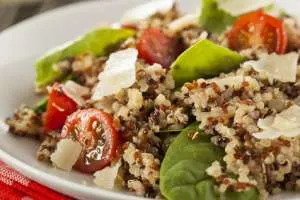Whether you are a vegetarian, or you’re simply looking to increase your protein intake, there are some great sources of protein that don’t involve meat at all. Just remember that plant-based proteins are not complete because they don’t contain all the necessary amino acids. For this reason, be sure to combine vegetable sources of protein with whole grains.
Quinoa
Quinoa is a gluten-free, protein-packed replacement for rice, couscous, or pasta. It contains a large amount of fiber, magnesium, iron and manganese. It can be used in cooking and baking. One cup of quinoa contains eight grams of protein. It is often paired with black beans, stuffed peppers, and is also used in breakfast casseroles.
Chia
Chia is an edible seed that comes from Salvia hispanica, a plant native to central and southern Mexico and Guatemala. As plant sources go, the seeds contain the highest amount of omega-3 fatty acids, as well as more fiber content than nuts. Chia is packed full of large quantities of calcium, iron, zinc, and antioxidants. Because of their gelatinous texture when mixed with water, these seeds can be used in smoothies, puddings, and in baking. Just one ounce of chia seeds contains 4.7 grams of protein.
Rice
Both brown and white rice are good sources of protein. In just one cup of cooked, long-grain white or brown rice you get 4–5 grams of protein. It is also an excellent source of phosphorus, magnesium, selenium, iron, manganese, thiamine, folic acid, and niacin. Rice is often paired up in recipes with beans, which together provide a real power-punch of protein.
Beans
As mentioned above, beans are an excellent source of protein and have the versatility to be used in a variety of tasty dishes. The beans with the highest protein content are lupini beans, lentils, great northern beans, kidney beans, black beans, pinto beans, chickpeas, and yellow beans. Consider tossing them in as an addition to your favorite recipe.
“You can make a really great meal with some whole-wheat flatbread, some veggies, and some homemade hummus,” said Christine Gerbstadt, M.D., R.D., author of Doctor’s Detox Diet. “Just toss a can of chickpeas in the blender with some herbs and some tahini or walnut oil and you’re good to go.”
Nuts
Virtually every kind of nut has a pleasing combination of healthy fat and protein. They are an invaluable ingredient in any plant-based diet. They have the flexibility to be eaten raw, dry roasted, or in a butter. Per ounce, almonds, pistachios and cashews have between five and six grams of protein.
“Look for brands with as few ingredients as possible — just nuts and maybe salt,” said Elle Penner, R.D., nutritionist for MyFitnessPal. “Skip the ones with hydrogenated oils or lots of added sugar.”
Leafy greens
Surprisingly, leafy greens contain decent amounts of protein, as well as antioxidants and fiber. Just two cups of spinach provide 2.1 grams of protein. A single cup of chopped broccoli provides up to 8.1 grams.

Hemp seeds
Hemp seeds are an amazing source of protein. In three tablespoons of hemp seeds, you can consume 10 grams of protein. They can be tossed into trail mix or cereal, blended into a smoothie, or used in baking. There is even hemp milk, which is a good source of protein, and best of all, it is dairy-free!
Green peas
Technically a part of the legume family, green peas deserve a mention all of their own. One cup of green peas can provide you with 7.9 grams of protein. They make an excellent side dish to many meals, but they are also good for blending into other recipes.
“I blend frozen peas, toasted pine nuts, fresh mint, olive oil, and Parmesan cheese and serve over linguine,” says Penner. “It’s one of my all-time favorite meat-free meals!”
Even if you are a meat lover, there is a lot to be gained from trying new foods and expanding your palate. Try the items mentioned above to give yourself a meat-free night without losing the valuable protein your body needs.
—Kristy Toth
Kristy is a freelance writer with more than twenty years of print and digital media writing experience and over seven years of university study in journalism, broadcasting, and mass communications. She specializes in health and wellness, alternative healing methods, news, the environment, and lifestyles. She currently resides in the Upper Peninsula of Michigan with her family and pets.
Sources:
http://www.womenshealthmag.com/nutrition/high-protein-vegetables?adbid=617698218013425666&adbpl=tw&adbpr=25087685&cid=socFO_20150705_48560156
http://greatist.com/health/complete-vegetarian-proteins
http://www.health.com/health/gallery/0,,20718479,00.html
http://vegetarian.about.com/od/healthnutrition/tp/protein.htm
